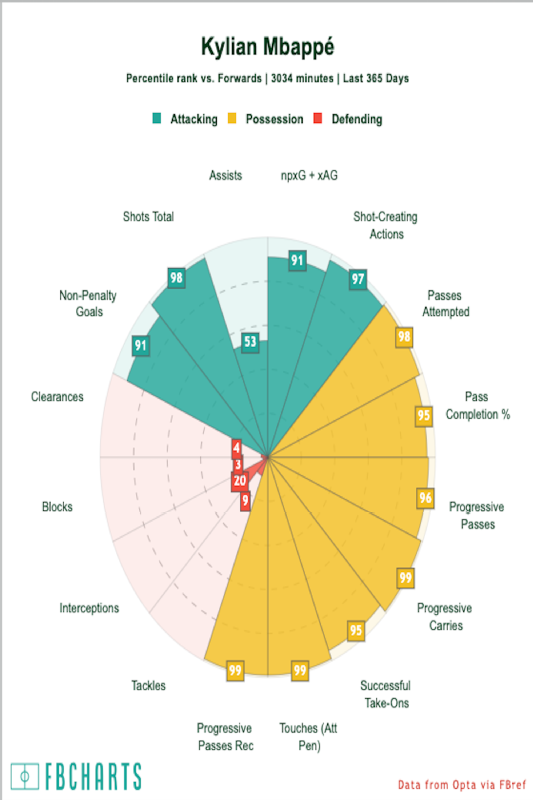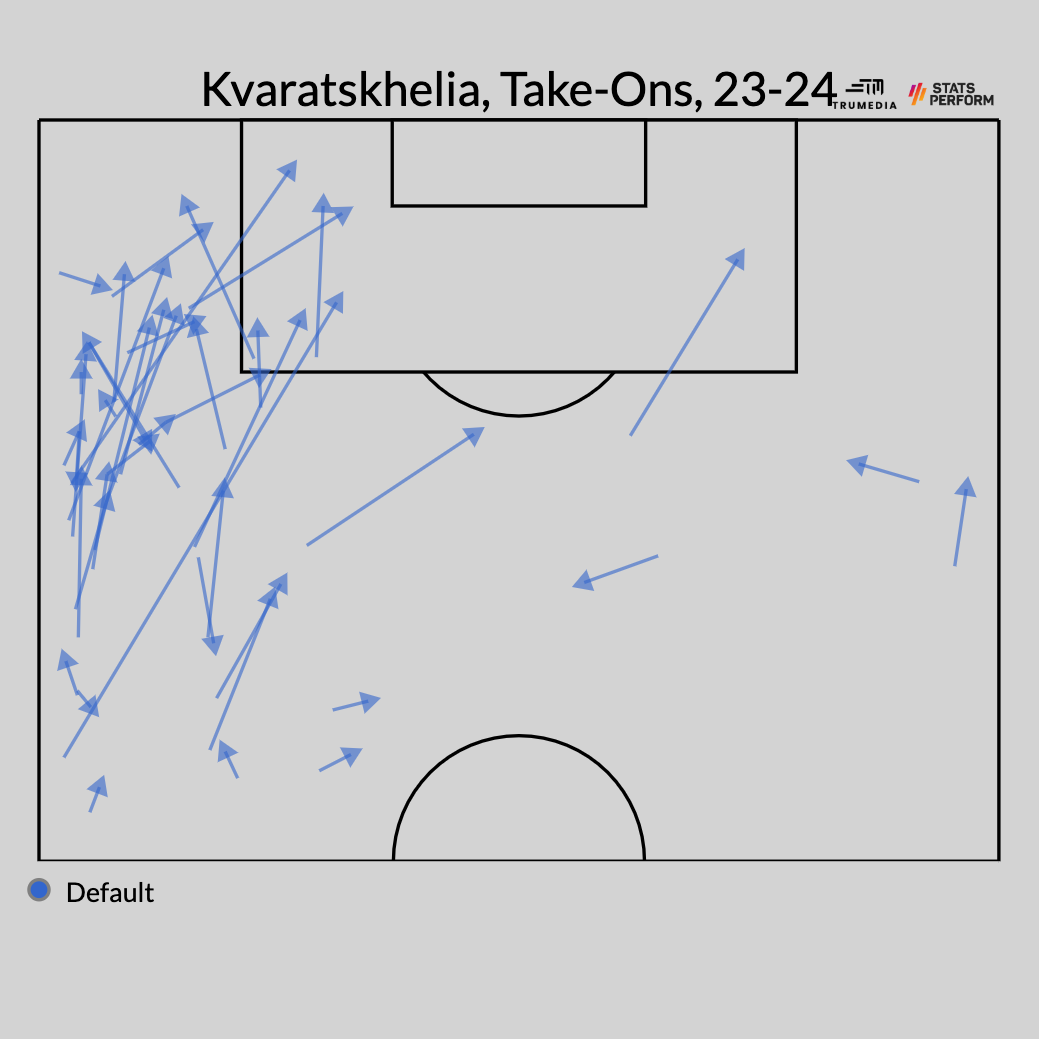Erling Haaland might be the best player in the world, but he can't dribble or pass. I mean, he can, and he does both of those things better than just about every other human being who has ever tried to dribble or pass a soccer ball. But compared to his peers -- the other best attackers in the world -- he's awful at attempting either one.
Despite playing on one of the most possession-dominant teams in the world, Haaland rates in the fourth percentile among all forwards across Europe's Big Five leagues in passes attempted per game over the past year. And he's in the 27th percentile for successful dribbles -- watch two Manchester City games, and you might see their starting striker beat a defender off the dribble just one time.
The other day, I spoke to someone who helped build a team that won the Champions League and multiple domestic trophies. He told me that in recruiting attackers, they tried to avoid players like Haaland. Not Haaland in particular -- he's so good that you just sign him and figure everything else out after the fact -- but rather elite-yet-one-dimensional players who require sacrifices across the rest of the team to cover up their deficiencies.
Instead, this club official and his team preferred what he called "triple threats." "If you can pass, shoot and dribble, you're a triple threat," he said.
While these players might not be, say, 99th percentile goal scorers like Haaland, they might be in the 80th percentile for all three areas, and the benefit of these types of players is that they almost naturally fit together and complement each other immediately. If one attacker is a threat to dribble, shoot or pass in any moment, the defense has to respect it; this opens up space for the other attackers, and then the chain reaction continues on and on as they move the ball to each other. Plus, this distribution of talent allows for fluid, unpredictable movement among the front three, and it's also easier to cover up for injuries when everyone can play anywhere and occupy any role.
Of course, only a handful of teams in the world can actually afford to acquire these players. "Most teams have to make a compromise," he told me. "It's a bit like that idea that you can have cheap, fast or good. Pick one of the three."
But I do think there's wisdom here in attempting to identify players who don't have one particularly standout skill but function at an above-average level at everything. So, first, we're going to use some rudimentary stats to pinpoint the sport's top triple threats, and then we'll see if we can find some potential future stars, too.
The ultimate triple threat
A quick word here before we continue on, with all of the players currently playing in one of Europe's Big Five leagues. It might be limiting to call him a triple threat, but the reason Lionel Messi is the greatest soccer player to ever do it is because he was the best dribbler, passer and shooter in the world -- all at once, for more than a decade.
Gab & Juls react to Bayern Munich's 4-0 win over Borussia Dortmund in Der Klassiker.
For the purposes of the first part of this exercise, I looked at players who've hit the following criteria, per Stats Perform, since the beginning of last season in Europe's Big Five leagues:
At least 2,000 minutes players
At least 3.0 shots attempted per 90 minutes
At least 2.5 passes completed into the penalty area per 90 minutes
At least 2.0 dribbles completed per 90 minutes
There are only seven guys who hit each of those benchmarks. Six of them still play in Europe, and Messi is the seventh. The others are all somewhere between 20 and 27 years of age. Messi is 36.
Last season with Paris Saint-Germain, Messi averaged 4.1 shots per 90, 5.3 passes into the box and 3.2 dribbles. So, yes, sure, he mainly won his eighth Ballon d'Or because he won the World Cup with Argentina, but it wasn't like he was just cashing paychecks in Paris. He was still doing what he has always done: everything, and better than almost anyone else.
The six other triple-threat stars
You're not going to believe it, but Kylian Mbappé also shows up on the list. And I might go so far as to call him a quadruple threat. Not only is he dominant once he gets the ball, he also drastically shifts the geometry of the opponent with everything he does off the ball, too. If you don't respect Mbappe's ability to break behind your defense, you're going to concede a lot of goals to him when he breaks onto passes behind your defense.
This image shows how he compares to all other forwards across the Big Five leagues across a number of key metrics, and, well:

He does it all. And at just 24, Mbappe is already not-defending at a veteran level, too.
As for the other names, the ones who aren't quite as obvious? We'll start with a pair of Serie A wingers who seem destined to become two of the most expensive transfers in the world at some point real soon: AC Milan's Rafael Leão and Napoli's Khvicha Kvaratskhelia.
The former is 24 years old, and you can just watch this and see it all:
Kvaratskhelia, meanwhile, is still only 22. With Napoli's relative struggles this season, it might seem like the superstar who came out of nowhere last season has finally come back to earth. That's just not the case -- at all. He's scoring and assisting at roughly the same rate as last season, but his non-penalty expected goals+assists rate has taken a massive leap, from 0.51 per 90, up to 0.78. Kvaratskhelia's also carrying the ball into the penalty area more often than last season and beating more defenders off the dribble.

After these two, Barcelona and Bayern Munich each have their own established, in-their-prime triple threats: Raphinha and Leroy Sané, respectively. And then after them sits the most interesting name on the list: Lyon's Rayan Cherki.
Bafflingly, Cherki hasn't played more than 52 minutes in a match since September. Perhaps related: Lyon have four points from 10 games and are currently bottom of the table in Ligue 1. Cherki turned 20 only in August, but over the past calendar year, he's in the 88th percentile among attacking midfielders and wingers in shots per 90, the 99th percentile for passes into the penalty area, and the 97th percentile for successful dribbles.
He's the most exciting under-21 player in the world who's not already at a super club. Per FBref's similar-player algorithm, Cherki's top three most-similar players are Sane, Real Madrid's Vinícius Júnior and Kvaratskhelia. This isn't a projection, either. These are the players he's most like right now. His prime is still nearly another half-decade away.
The next triple threats
If we lower the threshold by 0.5 across all three metrics -- at least 2.5 shots, 2.0 passes into the box and 1.5 successful dribbles per 90 -- then the list expands to 22 players.
Most of them are either well-known or not legitimate transfer targets. In the 30-plus range, there's Almeria's 31-year-old Adri Embarba and Galatasaray's 30-year-old Wilfried Zaha. They're the oldest players on the list not named Lionel Messi.
After that, there's a group of in-their-prime players either currently at bigger clubs or formerly of bigger clubs: Roma's Paulo Dybala (29), Bayern Munich's Kingsley Coman (27), Manchester United's Marcus Rashford (26), Tottenham's James Maddison (26) and PSG's Ousmane Dembélé (26). None of those players seems particularly likely to be leaving for a new club any time soon. Same goes for the likes of Real Madrid's Rodrygo (22) and Bayern's Jamal Musiala (20), two young stars still well short of their prime years.
So, that leaves us with six. One of them just moved for €55 million this past summer: Aston Villa's Moussa Diaby (24). In no small part because of his ability to contribute in three different ways, the Frenchman has hit the ground running, playing nearly 90% of the minutes for the team currently in fifth place in the Premier League.
Two of the others are already in their primes: Atalanta's Ademola Lookman (26) and Crystal Palace's Eberechi Eze (25). The former was lights out in half a season with RB Leipzig back in 2018, but never really put it together in any of the years since. He has been great for Atalanta in a more limited role, rather than as a play-every-game starter. It's easier to hit all of these statistical benchmarks when you don't play as much.
Eze, however, has played more minutes than all but four of the other 21 qualifying players over the past two seasons. And he made it onto the list despite playing for a mid-table Premier League side, frequently as a midfielder. Given how rich everyone in the Premier League is now, signing him won't be cheap, but I'd be really interested to see how his multifaceted game fits in at a Champions League-level team.
Borussia Dortmund's Donyell Malen (24) is already playing on a Champions League-level team, and he's leading all wingers and attacking midfielders across the Big Five leagues in shots per 90 minutes over the past 365 days. Udinese's Lazar Samardzic (21) was almost playing on a Champions League-level team, too, but his move to Inter Milan over the summer fell through. Given his age and the quality of the team he's on, Samardzic is the much more intriguing target. But Malen ripped up the Eredivisie with PSV over multiple seasons before taking a bit of time to find his feet with Dortmund. He might be a bit of a post-hype sleeper, too.
The issue with both players is twofold. First, both just barely meet the passing threshold. And second, Messi has played more domestic minutes in Europe than either of them since the start of last season. Your per-minute efficiency rarely improves with more playing time, and with any increase in overall time, their passing performance might suffer, negating any claim at triple threat status.
And then there was one: Sassuolo's Armand Lauriente (24). He's a live-wire driving dribbler, but no particular aspect of his statistical production stands out as elite. The site Transfermarkt estimates that his transfer value would be only somewhere in the €18 million range. Lauriente, though, qualified for the list despite a relatively heavy minutes load (3,264) since the start of last season while playing on a midtier Serie A side. On top of that, a number of metrics that attempt to estimate a player's overall impact also rate Lauriente much higher than you'd expect for an attacker who scored only six non-penalty goals last season.
Perhaps Lauriente, then, is the model player for this exercise. Nothing about him, on its own, stands out as a skill that would help a good team win more soccer games than would the hundreds of other acquirable wingers out there. But when you add it all together, you might have a player who's more valuable than anyone could realize by simply perusing top-level stats or watching all of his matches.
If I were a Premier League team, I'd give him a shot. For that kind of fee, wouldn't you?
